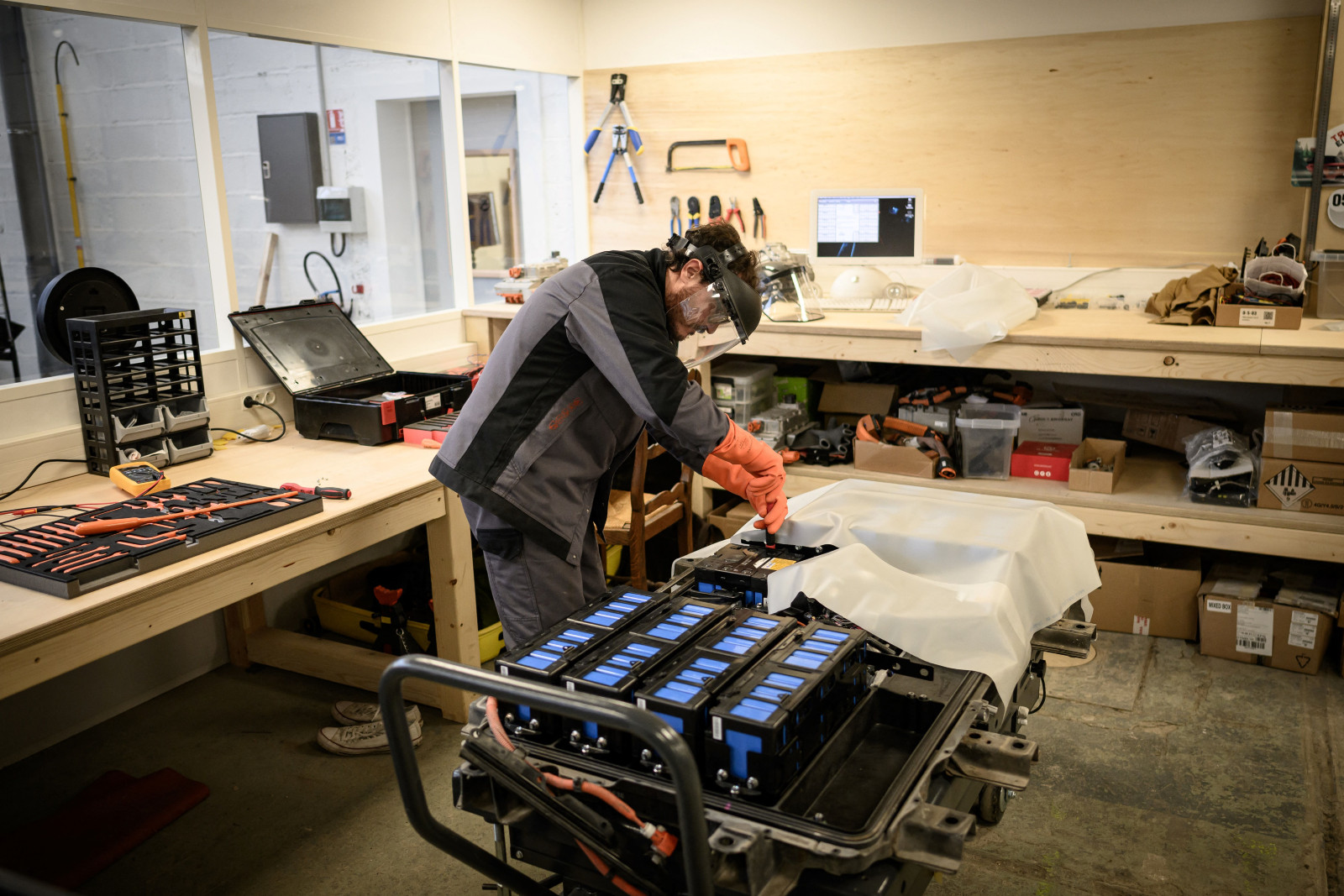About three times a day, Rich Benoit gets a call to his auto shop, The Electrified Garage, from the owner of an older Tesla Model S whose car battery has begun to fail. The battery, which used to provide several hundred miles of range, might suddenly only last 50 miles on a single charge. These cars are often out of warranty, and the cost of replacing the battery can exceed $15,000.
For most products, repair is a more affordable option than replacement. And in theory, lots of these Tesla batteries can be fixed, said Benoit, who runs one of the few Tesla-focused independent repair shops in the United States. But due to the time and training involved, the safety considerations, and the complexity of the repair, Benoit said that the bill to fix one car battery at his shop might run upwards of $10,000 — more than most consumers are willing to pay. Instead, he said, many choose to sell or donate their old vehicle for scrap and buy a brand new Tesla.
“It’s getting to the point where [the car] is almost like a consumable, like a TV,” Benoit said.
Benoit’s experience heralds a problem that early adopters of EVs, as well as electric micromobility devices like e-bikes and e-scooters, are beginning to face: These vehicles contain big, expensive batteries that will inevitably degrade or stop working over time. Repairing these batteries can have sustainability benefits, saving energy and resources that would otherwise be used to manufacture a new one. That’s particularly important for EVs, which contain very large batteries that must be used for years to offset the carbon emissions associated with making them. But many EV and e-mobility batteries are difficult to repair by design, and some manufacturers actively discourage the practice, citing safety concerns. The small number of independent mechanics who repair EV or e-bike batteries struggle to do so affordably due to design challenges, safety requirements, and a lack of access to spare parts.
“There’s a lot of batteries in the recycle bin that could be repaired,” said Timoté Rouffignac, who runs a small e-bike battery repair business called Daurema in Brussels, Belgium. But “because they are not made to be repaired, it’s quite hard to propose a good price.”
A lithium-ion battery in a smartphone contains a single “cell” consisting of a graphite anode, a metallic cathode, and a liquid electrolyte that allows lithium ions to move from one side to the other to generate an electrical potential. An e-bike battery often contains dozens of cells. EV batteries, meanwhile, can contain hundreds to thousands of individual cells, which are often packaged into “modules,” and from there, bundled into a battery pack. In addition to cells and modules, electric car and e-bike batteries typically include a battery management system that monitors the battery’s state of health and controls the rate of charging and discharging.
All lithium-ion batteries degrade with use and eventually need to be replaced. But when a battery contains many individual cells and other components, its lifespan can sometimes be extended through repair, a process that involves identifying and replacing the bad cells or modules and fixing other faulty parts, like a glitchy battery management system. In some cases, a single module is all that needs to be replaced. Swapping that module out, instead of replacing the entire battery, reduces demand for battery metals like lithium, as well as the carbon emissions tied to manufacturing replacement batteries (or new vehicles). That makes battery repair “highly desirable for a circular economy” — a system in which resources are conserved and reused — said Gavin Harper, a research fellow who studies battery sustainability at the University of Birmingham in the United Kingdom.
And while not necessarily cheap, repairing batteries can save money. Tyler Helps of Cox Automotive, which repairs in-warranty EV batteries on behalf of automakers and their dealers across the United States, said that in general, a refurbished EV battery is about half the cost of a new one. Since it began offering EV battery repair services in 2014, Cox Automotive estimates that it has saved over a gigawatt hour’s worth of batteries — enough to power about 17,000 new EVs — from being prematurely discarded.
“There’s a myriad of different reasons repair is vastly [more] beneficial than replacement,” Helps told Grist.
But battery repair is dangerous and shouldn’t be attempted at home or by novices, experts say. If battery cells are damaged during a repair attempt, it can cause a short circuit that leads to a fire or explosion. If the person attempting the repair isn’t wearing the proper high-voltage gloves, they could be electrocuted. “You’d be playing with fire” if you didn’t know what you were doing, said John Mathna, who runs the e-bike repair shop Chattanooga Electric Bike Co., noting that some e-bike batteries contain “enough current to kill someone.”

At a bare minimum, battery repair requires high-voltage training, electrical experience, personal protective equipment, and “a baseline understanding of the architectures and how the battery works,” Helps said. Those wishing to fix EV batteries also need equipment to lift the car off the ground and physically remove the battery, which can weigh thousands of pounds.
“There’s very few people that could or even should attempt something like this,” Benoit said.
But even those who have the proper training often struggle to repair EV or e-bike batteries because of how they are designed. Many e-bike batteries are housed in heavy-duty plastic cases that can be difficult, if not impossible, to open up without damaging internal components. Inside an e-bike battery, or inside individual modules of an EV battery, cells are often glued or welded together, making them difficult or impossible to replace individually. What’s more, as a 2021 report by the European Environmental Bureau highlighted, some e-mobility batteries contain software that causes the battery to shut down if it detects evidence of unauthorized tinkering.
Manufacturers argue that their batteries are designed to promote safety, durability, and high performance, which can come at the expense of repairability, and many offer free or discounted replacement batteries within the warranty period (typically around 2 years for major e-bike brands and 8 to 10 years or 100,000 miles for EVs). Repair advocates, on the other hand, contend that modular designs with reversible fasteners, such as clips or adhesives that can be unstuck, don’t necessarily compromise safety and that the benefits of designing for repair far exceed the costs.
European policymakers are beginning to listen to advocates. In August, the European Union adopted a new regulation aimed at fostering battery sustainability. Among other things, it includes a provision requiring that the batteries used in e-bikes and other “light means of transport” vehicles, like e-scooters, be repairable down to the individual cell level by independent professionals. The European e-bike industry, which strongly opposed this provision due to concerns over safety, battery certification, and legal liability issues, is now grappling with how to comply.
“We are still examining how the requirements of the new EU battery regulation can be made possible while complying with the applicable safety regulations and our high quality standards,” e-bike battery manufacturer Bosch told Grist. One challenge for manufacturers, Bosch noted, is the “contrary development in the USA,” which is “on its way to stronger regulations and higher standards for e-bike batteries and systems.”
Indeed, the federal Consumer Product Safety Commission recently announced that it is considering regulations for e-bikes and their batteries. This comes after a recent rash of e-bike battery fires that have also spurred a policy response on a local level. The New York City Council recently amended its fire code to prohibit “the assembly or reconditioning of a lithium-ion battery” using secondhand cells from another battery, which repairers sometimes do.

The city also recently enacted a law requiring that e-mobility manufacturers ensure their products’ batteries are certified to the UL 2271 design standard, which is intended to promote safety. Ibrahim Jilani, the global director of consumer technology at UL Solutions — a multinational company that tests safety certification standards for a wide range of industrial and consumer products and materials — said that repaired batteries can meet this standard. But the company doing the repair would be required to “keep the design exactly how it was prior to needing repair,” Jilani said, including using the same make and model of cells and electronic components. Battery repair shops would also need to submit to UL field inspections four times a year, which would cost them a little over $5,000 a year, Jilani said.*
Compared with e-bikes, lawmakers have been relatively quiet on EV battery repair. In the U.S., there are no specific laws or regulations that address the issue. The EU’s new battery regulation doesn’t touch on EV battery repair either, other than to suggest lawmakers update a separate vehicle regulation “to ensure that those batteries can be removed, replaced, and disassembled.”
That’s an idea that GDV, the German Insurance Association, “strongly supports,” a spokesperson told Grist. In October, the group published the results of a study that found EVs are a third more expensive to repair than similar gas-powered vehicles, a finding it attributed in part to the high costs of fixing or replacing batteries.
“There are a lot of automakers who do not allow battery repair, even in case of minor damages to the battery case,” a GDV spokesperson told Grist. Automakers sometimes choose to replace the battery if the car was involved in an accident that caused the airbags to activate. Both practices “will lead to an increase of repair costs,” and ultimately, higher insurance premiums, the spokesperson said.
New rules around EV battery repairability would come at a critical time. Helps, of Cox Automotive, said that two trends in EV battery design are occurring in parallel: “Batteries are either becoming very serviceable, or not serviceable at all.”
Some, like the batteries inside Volkswagon’s ID.4, feature LEGO-like modules that are easy to remove and replace. Others, like Tesla’s new 4680 structural battery pack, don’t include modules at all. Instead, all of the cells are bonded together and bonded to the pack itself, a design Helps described as “impossible to service.” If a bad cell group is found, the entire battery must be replaced.
“It’s still a fully recyclable battery,” Helps said. “You’re just not able to repair it.”
Tesla didn’t respond to Grist’s request for comment.
*Correction: This story originally misstated the nature of UL Solutions’ work and the costs associated with obtaining UL certification.
"do it" - Google News
December 08, 2023 at 04:46PM
https://ift.tt/k13Lf7e
EV battery repair is dangerous. Here's why mechanics want to do it anyway. - Grist
"do it" - Google News
https://ift.tt/EORcuKP
https://ift.tt/9V4kRFj
Bagikan Berita Ini














0 Response to "EV battery repair is dangerous. Here's why mechanics want to do it anyway. - Grist"
Post a Comment